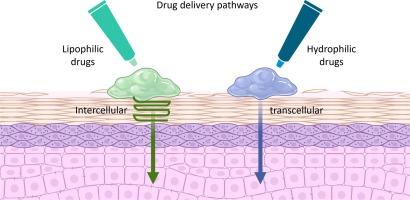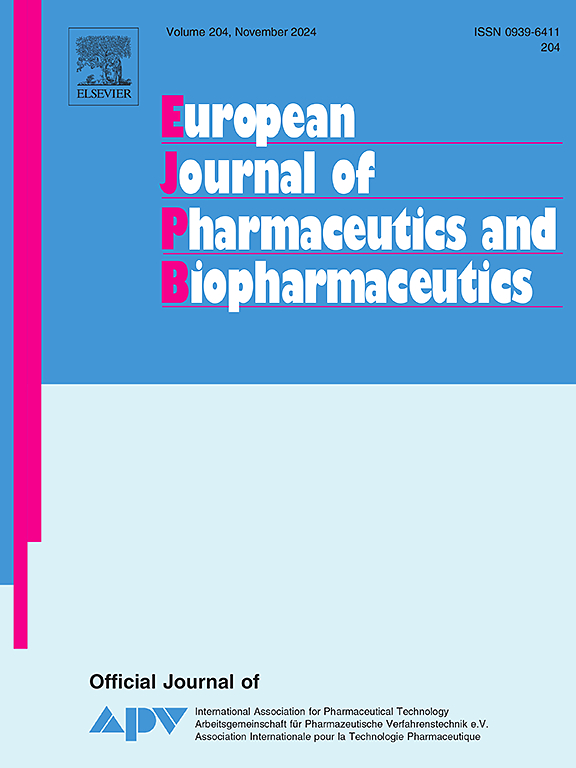利用受激拉曼散射显微镜鉴定皮肤渗透路径。
IF 4.4
2区 医学
Q1 PHARMACOLOGY & PHARMACY
European Journal of Pharmaceutics and Biopharmaceutics
Pub Date : 2024-10-01
DOI:10.1016/j.ejpb.2024.114518
引用次数: 0
摘要
了解物质渗透皮肤的机制对于开发安全有效的局部给药系统和护肤产品至关重要。本研究通过评估六种具有不同对数值的物质,研究了模型渗透剂在人体皮肤中的分配情况。我们采用了受激拉曼散射(SRS)显微镜,这是一种环境无标记光学成像技术,因其能够提供亚细胞分辨率的化学分布而闻名。我们的研究评估了物质穿过皮肤的两个主要途径:细胞间脂质基质和通过角质细胞的细胞内途径。我们观察到,分区行为受到分子亲脂性的强烈影响,亲脂性化合物随着亲脂性的增加而对细胞间基质表现出更大的亲和力。相反,亲水性分子则表现出对角质细胞的偏好,亲和力随着亲水性的增加而增加。这些发现有助于我们了解局部给药的基本机制,并为开发安全有效的局部产品提供了重要意义和新方法。此外,这些方法对于揭示药物分配的变化或评估病变皮肤模型的靶向方法也很有价值。本文章由计算机程序翻译,如有差异,请以英文原文为准。

Characterisation of skin penetration pathways using stimulated Raman scattering microscopy
Understanding the mechanisms governing the penetration of substances into the skin is crucial for the development of safe and effective topical drug delivery systems and skincare products. This study examined the partitioning of model permeants into human skin, by assessing six substances with diverse logP values. We employed stimulated Raman scattering (SRS) microscopy, an ambient, label-free optical imaging technique known for its ability to provide chemical distribution with subcellular resolution. Our investigation assessed partitioning into the two primary pathways through which substances traverse the skin: the intercellular lipid matrix and the intracellular route via corneocyte cells. We observed that the partitioning behaviour was strongly influenced by the lipophilicity of the molecule, with lipophilic compounds showing greater affinity for intercellular matrix with increased lipophilicity. Conversely, hydrophilic molecules demonstrated a preference for corneocyte cells, with their affinity increasing with increased hydrophilicity. The findings contribute to our understanding of the mechanisms underlying topical delivery and offer important implications and new methods beneficial for the development of safe and effective topical products. In addition, the methods presented could be valuable to reveal changes in drug partitioning or to assess targeting approaches in diseased skin models.
求助全文
通过发布文献求助,成功后即可免费获取论文全文。
去求助
来源期刊
CiteScore
8.80
自引率
4.10%
发文量
211
审稿时长
36 days
期刊介绍:
The European Journal of Pharmaceutics and Biopharmaceutics provides a medium for the publication of novel, innovative and hypothesis-driven research from the areas of Pharmaceutics and Biopharmaceutics.
Topics covered include for example:
Design and development of drug delivery systems for pharmaceuticals and biopharmaceuticals (small molecules, proteins, nucleic acids)
Aspects of manufacturing process design
Biomedical aspects of drug product design
Strategies and formulations for controlled drug transport across biological barriers
Physicochemical aspects of drug product development
Novel excipients for drug product design
Drug delivery and controlled release systems for systemic and local applications
Nanomaterials for therapeutic and diagnostic purposes
Advanced therapy medicinal products
Medical devices supporting a distinct pharmacological effect.

 求助内容:
求助内容: 应助结果提醒方式:
应助结果提醒方式:


